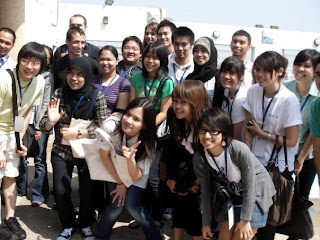
I, together with my group mates namely: Martine and Anke (Netherlands), Kathleen (Germany), Clara (France), Cin, Pat, Sulaiman and Golf (Thailand) summed up our amazing camp experiences which began with buffet dinner in honour of ASEM Youth Participants at the Ministry of Foreign Affairs in Sri Ayudhaya Road,Bangkok, that was followed by visits to the Ancient City and Crocodile Farm in Samutprakarn Province, then a briefing on self-sufficiency economy philosophy at Bhumirak Centre in Nakorn Nayok Province, where we also planted rice. Not over just yet of our dinner at Baiyoke Sky Tower Hotel, we went sightseeing the following day at the Temple of Emerald Buddha, Temple of the Reclining Buddha and Gold Mountain Temple. We also made brief visits to UNESCO world heritage sites in Ayudhya Province such as Wat Yai Chaimongkon, Bang-pa-in and the Chinese-style temple grounds( Wat Sam Po Kong.) We also met the former Senator of Bangkok, Mr. Damrong Puttan over lunch at his villa. Then we made visits to the Muslim communities and mosques, first Christian Church in Thailand (St. Joseph's Church built in 1666) and the Portugese Community. All of which was concluded with a dinner boat trip along Ayudhya river.

Sawasdee Ka! Good afternoon, I am Raiza from the Philippines.
Allow me to start by saying that this camp has provided us with a different kind of learning experience. This camp has not kept us insulated in the four corners of a room. It has allowed us to discover new ideas, experience a culture that may be similar to or different from ours; meet new friends that perhaps we can keep in our lifetime. Beyond these discoveries are learnings that can help us become a better individual, a better person of our country and better citizen of the world. Now our group have come-up with a list of words to explain what we have learned from this camp:


First, is LANGUAGE. From day one we were greeted by our host country, with amazing smiles that says sawasdee! Probably, this is not the only word we know of, and the list can go on, including all other languages from different parts of the world.

All the participants of this camp have enriched us with new discoveries about food, ways of life, traditions, history, or to simply put- share something about culture.



We discovered a lot about different faiths like Buddhism, Muslim, Shinto and the Christian faith. The learning is not confined to the discussion of religious practices. More importantly, we were all immersed in worship places, religious communities and perhaps in the heaps of information about our religion that we have kept in our pockets from where we live to here, in Thailand.




From the knowledge that we have acquired, we were able to magnify the traits, which I am sure we all share, like openness, tolerance and respect. Through communication or dialogue, we are able to share and understand not only our differences but also our similarities.



Apart from these new learnings, we have also discovered something about ourselves which perhaps we may not have given much thought of before. Alongside these learnings, I am sure you would agree with me when I say that we all have received the gift of friendship.


While we may all recognize the learnings, we cannot just keep them in our suitcases when we go back to our homes. The most important question we should all answer is ‘how are we going to share this with the world’? Our group listed 6 things, which we believe we can do:
1) Since most of the participants are part of institutions on education, we can come up with sharing sessions, conferences, or presentations that centers on inter-faith and culture, or probably hold an echo workshop.

2) To disseminate the information we have acquired from this youth camp, it would be very interesting to share it through print media, such as newspapers or publish artworks, and I wouldn’t go as far as saying that as a youth, we can tap on resources which are very close to us, like school papers.
3) We can also take initiative on projects that caters on youth from various faiths, to provide more venues for dialogue. Perhaps, we could initiate clubs or centers, open to all young people to freely discuss faith and culture. In this way, we can promote the lessons we have acquired from this camp such as tolerance, understanding and openness.

4) In moving with the current or modern times, we can also go digital through initiatives like an online discussion board where we could share many things about culture, religion or faiths, all encompassing.
5) To foster interaction among youth of various faiths, we can tap on our creative talents and contribute in providing information about faith and culture through the arts. It could be any form of visual arts, such as paintings, songs or photography. This is consequential to the fact that language could at times be a barrier. Of course, the English language do not have to be the common language to explain concepts from our faiths, practices or traditions.



6) Or better yet, we can go for the simplest way to echo the things we have learned from the camp, and that is through our very selves. We could be instruments of promoting respect, openness, dialogue and tolerance among others, through sharing the things we have learned from this camp, to our family, friends, neighbors, and to everyone.

We can do all these, until all of us can realize that the world’s circumference is too small to waste upon ill feelings; that life is good and we can live a happy life.

Allow me to end this by sharing the most important lesson I have learned from this camp and that is: we could use diversity as a language to communicate and experience to be the best tool to learn a lot.

Khob-kun-kah…Thank you very much!!!